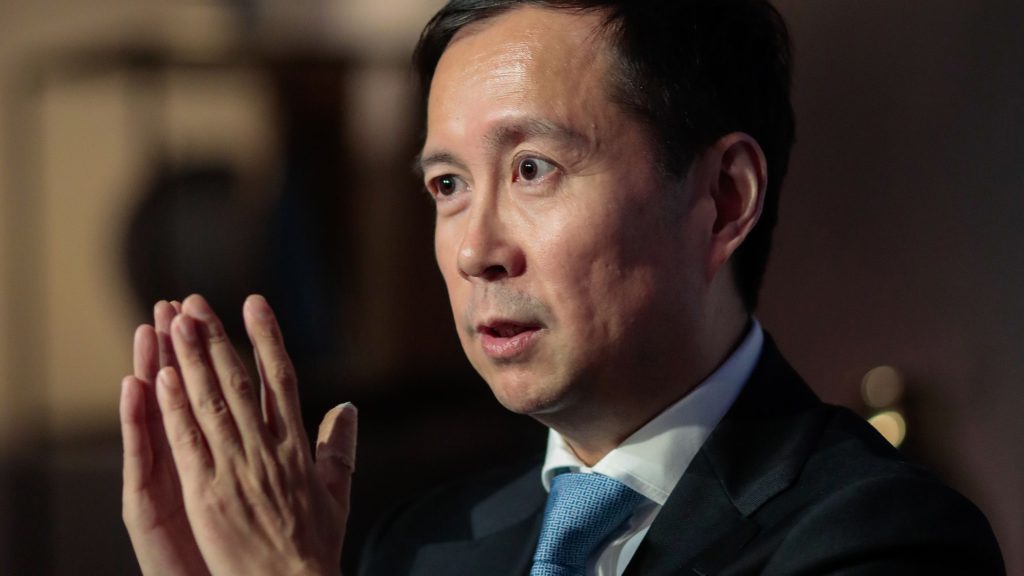(Bloomberg) — Alibaba Group Holding Ltd. unveiled a sweeping blueprint to grow its international business and delve deeper into an under-served 15 trillion yuan ($2.4 trillion) rural Chinese e-commerce market, laying out its recovery plan after a devastating year marked by political and economic turmoil.
Chief Executive Officer Daniel Zhang and his lieutenants on Friday identified overseas business, poorer cities and cloud technology among the company’s prime growth drivers in the years ahead. Their multi-layered presentations during the company’s annual investor conference underscored how Alibaba is keen to show it’s got an answer to intensifying competition, dwindling consumer spending and Xi Jinping’s campaign to curtail the growing influence of internet titans from Alibaba to Tencent Holdings Ltd.
Investors are concerned about the longer-term picture for growth after Alibaba in November cut its fiscal 2022 revenue outlook. Alibaba, the pillar of embattled billionaire Jack Ma’s Chinese corporate empire, was one of the first targets of Beijing’s campaign to clip the wings of a tech sector that had grown immensely powerful during a decade of near-unchecked expansion. While it settled an initial antitrust probe via a record $2.8 billion fine, questions remain around its hoard of data and media platforms — both of which the Communist Party considers vital to maintaining stability and control.
Regulatory turmoil compounds uncertainty around the health of the Chinese consumer. The country’s economy slowed further in November, dragged down by a worsening property market slump and disruptions from repeated Covid outbreaks. Alibaba, which at its peak was Asia’s largest corporation with a $860 billion market value, has plummeted more than 60% since and is now lagging old-economy stalwarts like Chinese liquor maker Kweichow Moutai Co. and Samsung Electronics Co.
“In the past, we have met and overcome huge challenges on numerous occasions,” Toby Xu, who will take over from Maggie Wu as Chief Financial Officer in April, said on a webcast presentation to investors. “Today, we are equally confident that we will succeed in delivering sustained, durable growth by taking the long-term view while tackling current issues pragmatically.”
Read more: Alibaba Aims for Carbon Neutrality From Its Operations by 2030
To counter the headwinds, Alibaba is embarking on a period of sustained investment into the areas that could yield greatest growth over the longer term: its domestically leading cloud division, local services such as food and grocery delivery, and logistics. Alibaba’s cloud division, its second-largest revenue contributor, was a bright spot in the latest September quarter. Sales at that unit grew 33% during the period, accelerating thanks to investments in technology.
Meanwhile, e-commerce has achieved close to 99% penetration in China’s richest cities. That means taking on foes from Meituan to JD.com Inc. and Pinduoduo Inc. head-on in rural arenas and poorer cities.
“Offense is the best defense,” Xu said. “Our peers are increasing investment to attract users, and most of them continue to exhibit elevating level of spending and losses.”
What Bloomberg Intelligence Says:
Alibaba, Meituan and Pinduoduo may struggle more than peers to boost profitability and reduce losses in fiscal 2022-23 amid heavier cost burdens and lower free cash flow for mainland China e-tailers next year. Such pressures, along with slowing online retail sales growth in 2022, could limit upside to sector valuations in the next 12 months.
— Catherine Lim, analyst
Click here for the research
The company is also again looking outward, as embodied by Ma’s longstanding pledge — now rarely mentioned — to eventually serve 2 billion users around the world. The company has reported more than 1.2 billion annual active consumers — 953 million of which were in China — over the past 12 months, and has said it’s on track to hit a billion in China before the end of the fiscal year.
Lazada, Alibaba’s Southeast Asian arm, Trendyol in Turkey and Daraz around South Asia have evolved into important units of the company. Alibaba outlined a long-term goal of quintupling gross merchandise value, the sum of transactions across Lazada’s platforms, to $100 billion. It wants Lazada to serve more than 300 million users eventually, according to a slideshow posted on its website.
“E-commerce continues to evolve,” Zhang said. “But its essence remains unchanged, it’s all about satisfying consumer demands.”
More stories like this are available on bloomberg.com
©2021 Bloomberg L.P.











